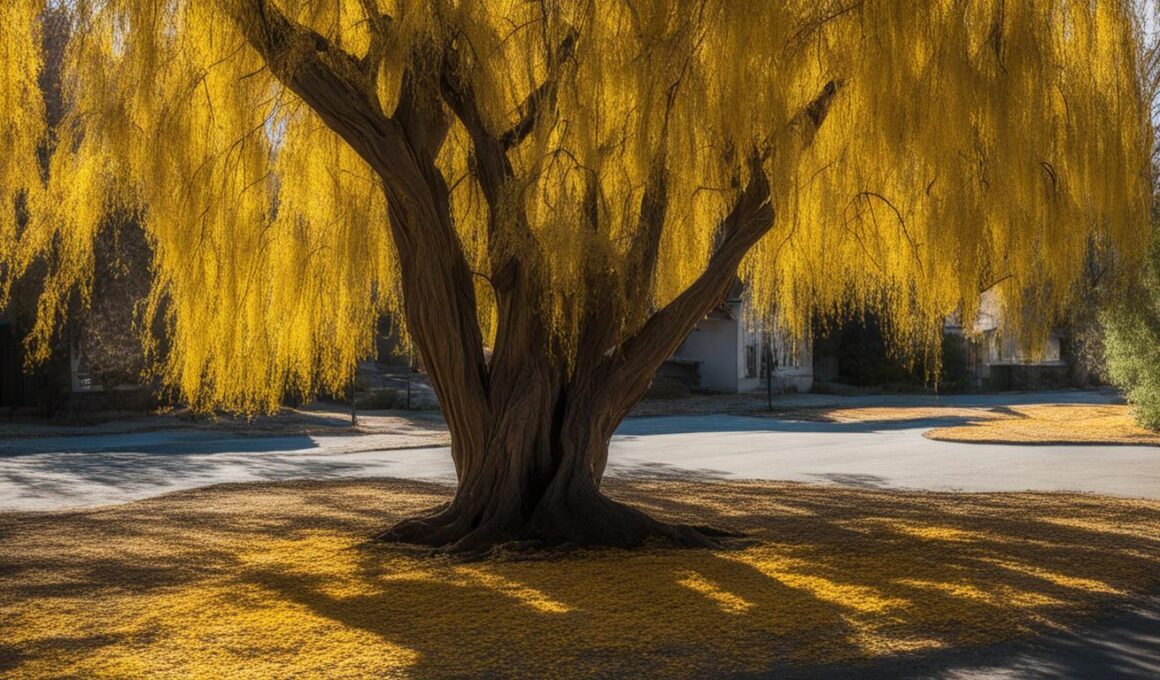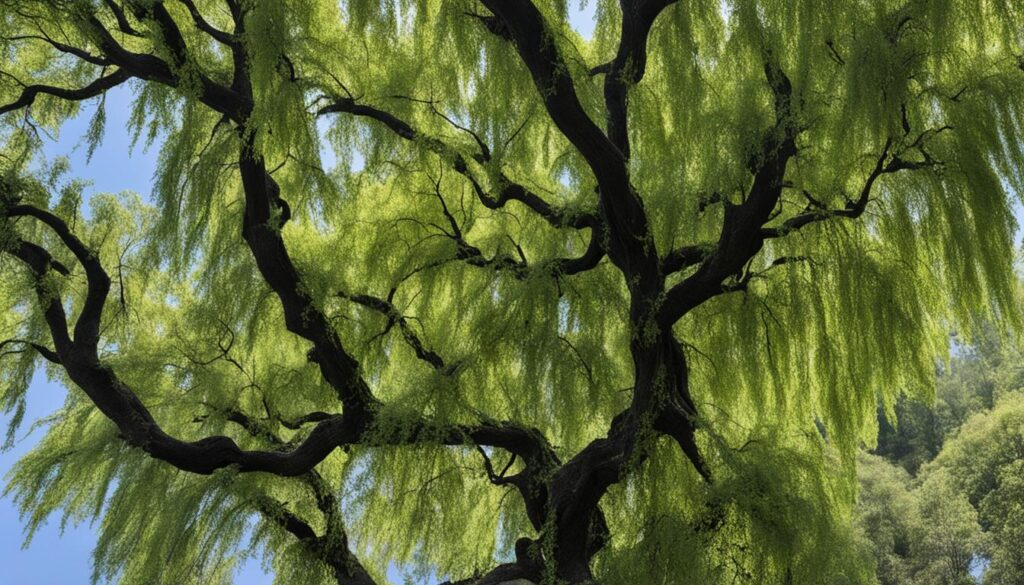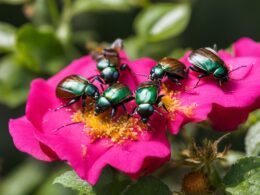Welcome to our guide on troubleshooting common problems with dappled willow trees. If you own a dappled willow, also known as Salix integra ‘Hakuro-nishiki,’ you may encounter various issues that can affect the health and vitality of your tree. In this article, we will discuss the common problems that dappled willow owners face and provide tips on how to address them.
Dappled willows are generally undemanding plants, but they can be susceptible to diseases and pest infestations. Proper cultural care is crucial for maintaining the health of your dappled willow tree. This includes providing moist, fertile, and well-draining soil, as well as regular fertilization. Factors such as prolonged heat, poor drainage, lack of water, and compacted clay soil can also contribute to problems with dappled willows.
By identifying specific issues, such as leaf loss, powdery fungus, sticky sap, or leaf damage, you can effectively troubleshoot and address common problems. In the next sections, we will provide a comprehensive care guide for dappled willows, explore common diseases and pests that affect these trees, and offer tips for maintaining their health. Let’s get started!
Dappled Willow Care Guide
Proper care and maintenance are essential for the health and well-being of dappled willow trees. By following the guidelines below, you can ensure that your dappled willows thrive and flourish.
Soil Requirements
Dappled willows thrive in moist, well-drained soil. They prefer a slightly acidic to alkaline pH. While they can tolerate poor soil conditions, optimal growth and foliage color are best achieved in fertile soil.
Light Requirements
Dappled willows require full sun for the best color production. However, they can tolerate partial shade or partial sun.
Water Requirements
Regular watering is necessary to keep the soil moist, especially during the early stages of growth. Once established, dappled willows can be watered less frequently, but they should never be allowed to dry out completely.
Temperature and Humidity Preferences
Dappled willows can tolerate a wide range of temperatures. However, extreme cold can be detrimental to the plant. It is important to protect them from freezing temperatures and harsh winter conditions.
Fertilizer Recommendations
Fertilize your dappled willows with a slow-release fertilizer in early spring. This will help maintain lush foliage and promote healthy growth.
Propagation Tips
Propagation of dappled willow can be done through stem cuttings. Take cuttings in early spring and place them in a well-draining potting mix. Provide the appropriate moisture and temperature conditions for successful propagation.
Pruning Techniques
Pruning should be done during late winter or early spring when the plant is dormant. Remove any dead or damaged branches and shape the tree as desired. Regular pruning helps maintain the health and appearance of dappled willows.
Proper care and maintenance will ensure the health and vitality of your dappled willow trees. Follow these care guidelines to enjoy the stunning foliage and graceful presence of these beautiful trees in your garden.
Common Diseases and Pests of Dappled Willow
Dappled willow trees are prone to various diseases and pests that can cause harm to the plant. Understanding these common problems is essential for maintaining the health and vitality of your dappled willow tree. Some of the most encountered diseases include:
- Rust: This fungal disease appears as orange or brown spots on the leaves, causing them to wither and fall prematurely.
- Powdery Mildew: A white, powdery fungal coating that appears on the leaves, inhibiting their ability to photosynthesize and weakening the overall health of the tree.
- Leaf Spot: This disease causes dark spots or lesions on the leaves, leading to yellowing, browning, and defoliation if left untreated.
- Blight: Blight is a bacterial or fungal infection that causes sudden wilting, browning, and death of branches or the entire tree.
Pests can also pose a threat to dappled willow trees. The most common pests to watch out for include:
- Aphids: These tiny insects feed on the sap of the leaves, causing curling, yellowing, and stunted growth.
- Caterpillars: Caterpillars can chew on the leaves, leading to defoliation and weakening of the tree.
- Leaf Beetles: Leaf beetles consume the foliage of dappled willows, resulting in skeletonized leaves and reduced vigor.
- Powdery Mildew: Powdery mildew can also be caused by certain pests, such as lace bugs, which leave behind white specks and a powdery coating on the leaves.
It’s crucial to promptly address diseases and pests to prevent further damage and maintain the health of your dappled willow. Pruning affected branches can help prevent the spread of diseases while providing proper spacing between willow trees allows for adequate airflow and reduces the risk of infection. Regularly inspect your dappled willow for signs of disease or pest infestations and take early intervention measures to manage them effectively.
By actively identifying and addressing the common diseases and pests associated with dappled willow trees, you can protect the health and beauty of your tree. Stay vigilant and take the necessary steps to ensure the longevity and vibrancy of your dappled willow.
Conclusion
In conclusion, troubleshooting common problems with dappled willow trees requires proper identification of the issue and implementing appropriate care and maintenance practices. By providing the necessary cultural care, such as ensuring moist, fertile soil and regular fertilization, you can prevent many problems with your dappled willow. It is important to be aware of common diseases and pests that can affect dappled willows and take proactive measures to control and prevent their spread.
Regular pruning and inspection of the tree can help maintain its health and longevity. By following these tips and guidelines, you can ensure the vibrancy and beauty of your dappled willow tree. Remember to provide your tree with the right soil conditions, adequate water, and proper fertilization for optimal growth. Being proactive in identifying and addressing any issues that arise will go a long way in maintaining a healthy dappled willow tree.
In summary, here are the key tips for maintaining a healthy dappled willow:
- Ensure the soil is moist, fertile, and well-draining.
- Regularly fertilize the tree to promote lush foliage.
- Be aware of common diseases and pests and take preventive measures.
- Prune the tree during the appropriate season to maintain its shape and health.
By following these guidelines, you can troubleshoot common problems, promote the health of your dappled willow, and enjoy the beauty of this unique tree for years to come.
Can Dappled Willows Be Harmful to Cats?
Dappled willows are not known to have harmful effects on cats, unlike carnations. Cats are generally safe around dappled willows, which are non-toxic to them. However, it’s always best to monitor your cat around any new plants and seek veterinary advice if concerned.










